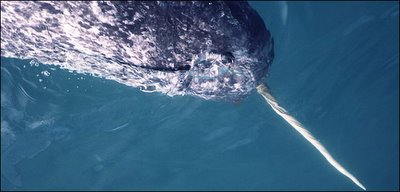 I heard a fascinating interview on the radio on the way into work this morning describing the narwhal research project detailed in this NY Times piece, whence the picture comes.
I heard a fascinating interview on the radio on the way into work this morning describing the narwhal research project detailed in this NY Times piece, whence the picture comes.We have known about narwhals and their tusks - passed off as "unicorn horns" in earlier times - for many years. But we have only speculated about the tusk's function (spearing fish?, breaking ice?, digging the seabed for food?) until this study.
Turns out the tusk is really a sensory organ, a nine-foot probe covered in nerve endings that allow the animal to detect subtle changes of temperature, pressure, and particle gradients in its environment. Pretty cool!
It occurs to me that the fact it took this long to answer such a basic question about this animal's anatomy may say more about the difficult logistics of fieldwork in the Arctic as anything.
1 comment:
My sole Eskimo (Inuit) stone sculpture is a little narwhal with a bone tusk. It's a sort of totem from when I was going to school in Chicago and needed a place to cool out and regroup. That place was often the life-sized full-mounted diorama of narwhals in the basement of the Field Museum of Natural History. The hall was kept dark and there was a bench in front of the "undersea" creatures. Pretty easy to zone out and imagine their lives down there -- except that in those days the thought that came to mind when looking at the tusk was, as you note, "en garde!"
Post a Comment